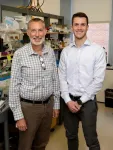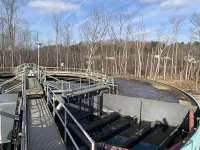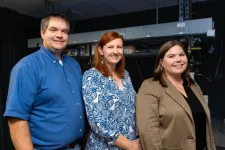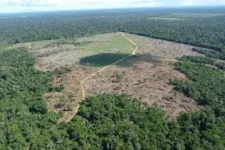(Press-News.org) As one of the largest heat reservoirs in the climate system, the global ocean absorbs more than 90% of the excess energy from ongoing anthropogenic warming. In the last century, the greatest warming in the ocean has occurred in the upper 500 m, with relatively weak warming in the deep ocean, corresponding to a small ocean heat storage efficiency of ~0.1.
Paleoceanographic observations, however, suggest that on long time scales, the deep ocean warming can be comparable to or larger than the surface ocean warming, with ocean heat storage efficiency during the last deglaciation about ten times of its modern value. This raises the following question: what mechanisms are responsible for ocean heat uptake/storage and how large can its efficiency be?
Recently published in Science Advances, a joint study by an international team of scientists from China and USA has shed light on this issue. By combining state-of-the-art deglacial simulations and proxy-based reconstructions, they resolved the three-dimensional deglacial ocean temperature change and found that the deglacial ocean heat storage efficiency is substantially enhanced to ≥1 by strong warming in intermediate-depth waters in response to deglacial forcing.
“Our simulations and proxy reconstructions demonstrate that the three-dimensional ocean warming during the last deglaciation was strongly nonuniform with strongest warming occurring at intermediate depths, in striking contrast to contemporary observations,” said Dr. Chenyu Zhu from Institute of Atmospheric Sciences at the Chinese Academy of Sciences, the study's co-first author.
Utilizing sensitivity experiments, the study revealed that the large warming of intermediate waters can be related to surface warming at mid-to-subpolar latitudes through ventilation in response to greenhouse gases and ice sheet forcing and substantially enhanced by oceanic circulation change associated with meltwater forcing. “The unique ocean warming structure facilitates a large ocean heat storage efficiency. In particular, this resolves the paradox suggested by the conventional view that warming occurred at sites of deep-water formation that remained covered by sea ice”, said Prof. Zhengyu Liu, one of the corresponding authors of the study from The Ohio State University.
“These results have valuable implications. For example, if strong surface warming and strong ventilation are collocated like in our simulations, then the ocean will absorb more heat from the atmosphere, potentially slowing the rate of atmospheric warming” said Prof. Peter U. Clark, another corresponding author of the study from Oregon State University.
The study underscores the important role of surface warming pattern and oceanic circulation change in long-term ocean heat storage change and suggests that “the ocean can serve as a far greater reservoir of energy in the climate system than implied by contemporary observations,” according to the study.
END
Study reveals large ocean heat storage efficiency during the last deglaciation
2024-09-20
ELSE PRESS RELEASES FROM THIS DATE:
Fever drives enhanced activity, mitochondrial damage in immune cells
2024-09-20
Fever temperatures rev up immune cell metabolism, proliferation and activity, but they also — in a particular subset of T cells — cause mitochondrial stress, DNA damage and cell death, Vanderbilt University Medical Center researchers have discovered.
The findings, published Sept. 20 in the journal Science Immunology, offer a mechanistic understanding for how cells respond to heat and could explain how chronic inflammation contributes to the development of cancer.
The impact of ...
A two-dose schedule could make HIV vaccines more effective
2024-09-20
One major reason why it has been difficult to develop an effective HIV vaccine is that the virus mutates very rapidly, allowing it to evade the antibody response generated by vaccines.
Several years ago, MIT researchers showed that administering a series of escalating doses of an HIV vaccine over a two-week period could help overcome a part of that challenge by generating larger quantities of neutralizing antibodies. However, a multidose vaccine regimen administered over a short time is not practical for mass vaccination campaigns.
In a new study, the researchers have now found that they ...
Wastewater monitoring can detect foodborne illness, researchers find
2024-09-20
UNIVERSITY PARK, Pa. — First used in the 1940s to monitor for polio, wastewater surveillance proved such a powerful disease monitoring tool that the U.S. Centers for Disease Control and Prevention (CDC) established the National Wastewater Surveillance System to support SARS-CoV-2 monitoring in September of 2020. Now, a team of scientists from Penn State and the Pennsylvania Department of Health have shown that domestic sewage monitoring is useful for a foodborne pathogen as well.
In findings published today (Sept. 19) in the Journal of Clinical ...
Kowalski, Salonvaara receive ASHRAE Distinguished Service Awards
2024-09-20
Building equipment and envelope scientists at the Department of Energy’s Oak Ridge National Laboratory were recognized for research excellence during the ASHRAE 2024 summer conference held in Indianapolis.
Stephen Kowalski and Mikael Salonvaara received the Distinguished Service Award, which salutes members who have served the society with distinction in chapter, regional and society activities. Kowalski and Salonvaara have each been active members of ASHRAE for more than 25 years and have supported the organization’s Technical and Standards Project Committees.
ASHRAE is the largest international professional organization ...
SkAI launched to further explore universe
2024-09-20
Funded by a five-year, $20 million grant from the U.S. National Science Foundation (NSF) and the Simons Foundation, the National Center for Supercomputing Applications is partnering with other academic institutions and federal laboratories in the Midwest to develop new artificial intelligence (AI) tools to advance astrophysics research and exploration of the universe.
Led by Northwestern University, the collaboration will establish the NSF-Simons AI Institute for the Sky or SkAI (pronounced “sky”), one of two AI research centers that will help astronomers better understand the cosmos.
Located close to NCSA’s home in Illinois, SkAI will ...
SLU researchers identify sex-based differences in immune responses against tumors
2024-09-20
ST. LOUIS — Researchers at Saint Louis University School of Medicine investigated differences in T-cell responses between male and female patients with lung cancer that may help direct future treatments. T-cell responses are part of the adaptive immune system, part of the body’s “smart system” that monitors for threats and fights them with customized defenses.
"Therapies that use the patient's immune system to fight their disease have a lot of potential to ...
Evolved in the lab, found in nature: uncovering hidden pH sensing abilities
2024-09-20
By Andy Flick, Evolutionary Studies scientific coordinator
In a groundbreaking study led by Sarah Worthan, Ph.D., a postdoctoral researcher in the Behringer Lab at Vanderbilt University, scientists have successfully evolved microbial cultures that possess the ability to sense pH changes, enabling rapid responses to environmental fluctuations. Along with highlighting the power of lab-driven evolution, this discovery also led to finding similar mutations in nature in emerging pathogens and coral symbionts—organisms that navigate challenging pH shifts in their environments and are ...
Unlocking the potential of patient-derived organoids for personalized sarcoma treatment
2024-09-20
Investigators at the UCLA Health Jonsson Comprehensive Cancer Center have developed the largest collection of sarcoma patient-derived organoids to date that can help improve the understanding of the disease and better identify therapies that are most likely to work for each individual patient.
The approach, detailed in the journal Cell Stem Cell, uses patients’ own tumor cells that replicate the unique characteristics of a patient's tumor allowing scientists to quickly screen a large number of drugs in order to identify personalized treatments that can target this rare and diverse group of cancers.
“Sarcoma is a rare and complex disease, which makes conducting clinical trials ...
New drug molecule could lead to new treatments for Parkinson’s disease in younger patients
2024-09-20
A novel drug molecule could potentially lead to new treatments to prevent Parkinson’s disease in younger patients, according to new research.
“We are excited about this drug compound because we might have the possibility to develop the first cure for Parkinson’s disease, at least for a subset of patients,” said lead author Kalle Gehring, a Professor in the Department of Biochemistry at McGill University and Canada Research Chair in Structural Studies of Neurodegenerative Diseases.
While Parkinson’s symptoms — slowed movements, tremors and balance problems — often appear in ...
Deforestation in the Amazon is driven more by domestic demand than by the export market
2024-09-20
Brazilian Legal Amazonia (BLA) – which comprises the entirety of the Amazon Basin located in Brazil and vast adjacent swathes of the Cerrado, spanning nine states – is more than 5 million square kilometers (km2) in area and corresponds to almost 60% of the country’s land mass. Almost a quarter of this area (23%) has been deforested, and over 1 million km2 are degraded, so that the region risks reaching an ecological tipping point at which ecosystems collapse and billions of tons of carbon are released into the atmosphere. Some parts of ...





